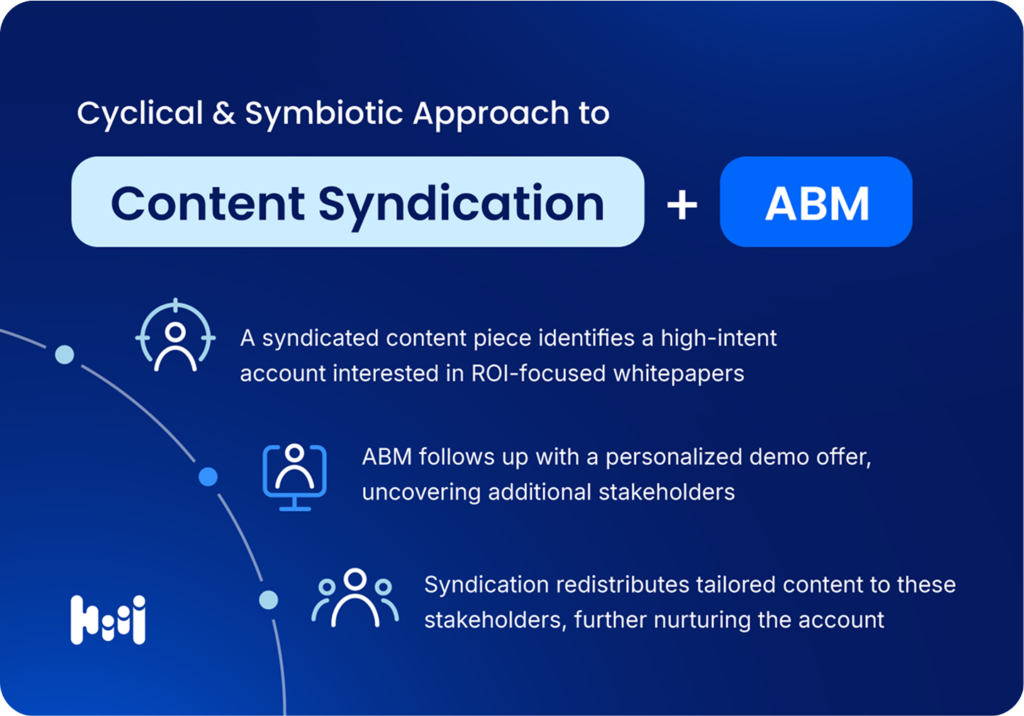Stop Thinking Linear: Why Content Syndication and ABM Work Better as a Cycle
July 8, 2025

B2B marketing today is a maze. It’s messy, fragmented, and non-linear. Accounts interact with multiple touchpoints before they’re ready to convert. Buyers interact with multiple touchpoints, reading blogs, downloading whitepapers, clicking on ads, often revisiting the same content before taking action.
Simply filling the funnel and hoping for sales to work their magic and convert anything that comes in won’t suffice anymore.
Many B2B marketers still struggle with disconnected strategies; one team focuses on building awareness, while another aims for accurate targeting. The result? Leads that look good on paper but don’t convert.
But what if these two approaches didn’t have to compete? What if you could combine broad awareness and precise targeting into a single, unified strategy that strengthens lead quality and accelerates pipeline growth?
Here’s the real problem: while ABM is designed to be always-on, its effectiveness hinges on a continuous influx of high-quality signals and engagement. Without this, even the most robust ABM programs can lose momentum. Conversely, many marketers treat content syndication solely as a top-of-funnel tactic, concluding its role once leads enter the pipeline. The result?

Discover a smarter, more effective solution.
The integration of content syndication and ABM transforms scattered marketing efforts into a unified strategy that drives measurable results. Yet, the ultimate solution lies in creating a unified, cyclical strategy where Content Syndication and ABM continuously feed into one another to close gaps, align teams, and improve ROI.
The Evolution of Content Syndication and ABM
Traditionally, content syndication and ABM have been treated as two distinct tools:
- Content syndication raises awareness at the top of the funnel, distributing content to broad audiences.
- ABM engages high-value accounts further down the funnel with personalized messaging.
But here’s where the problem lies: Linear approaches create stagnation.
Leads fall out of the funnel, content is underutilized, and opportunities are lost. A whitepaper created for an ABM campaign, for instance, often sits unused once the campaign ends. Instead of repurposing content and redistributing it to other decision-makers or similar accounts, its potential fades.
What’s the fix? Moving to a cyclical model where insights and content flow between content syndication and ABM.

Content Syndication That Doesn’t Suck
From Stagnation to Momentum: The Benefits of a Cyclical Model
Marketers may have basketed content syndication as a simple “awareness play” for content distribution. A way of getting content out into the world and filling the top of the funnel. However, stopping at awareness overlooks the broader opportunities it offers.
If your syndication efforts stop at awareness, then you’re missing the real value. Sure, you’ve put your content in front of the audience, but are you continuing to guide them? You should be using the insights gathered to refine your strategy and target high-value accounts instead of simply hoping they move on their own to the next stage of the funnel.
Content syndication could be a fuel that powers every stage of the buyer journey, too.
When you shift your perspective, content syndication becomes an always-on engine that amplifies ABM outcomes. It identifies the accounts that matter, provides actionable signals, and ensures your content keeps working, long after the first touchpoint.
Think of content syndication and ABM as interconnected gears. When one turns, it propels the other. In a cyclical process:
- Insights Drive Accuracy: Engagement data from Content Syndication refines ABM targeting and messaging.
- Momentum Builds Continuously: Accounts are never left idle. Syndication keeps prospects aware, while ABM deepens their interest.
- Scalability Meets Personalization: This model delivers broad awareness at scale while maintaining laser-focused engagement for high-value accounts.
This approach doesn’t just generate awareness; it sustains momentum, keeps accounts engaged, and ensures every asset fuels ongoing marketing efforts. Rather than forcing buyers through a rigid funnel, the cyclical approach mirrors their real-world behavior: nonlinear, dynamic, and highly interactive.
READ: Account-Based Marketing: Guide to Innovative Lead Targeting
Building a Symbiotic Content Syndication and ABM Framework
There’s a common misconception that lead generation and ABM are competing strategies—that you either cast a wide net or go all-in on high-value accounts. But in reality, the most effective go-to-market strategies do both—and use them together to drive full-funnel success.
Lead generation focuses on generating interest, typically at the top of the funnel. It’s about bringing new contacts into your ecosystem, identifying individuals within target accounts, and surfacing early buying signals. It’s often faster-moving, volume-driven, and optimized for awareness and engagement.
ABM, on the other hand, is a longer-term play. It’s built around nurturing entire buying committees within key accounts. It supports full customer lifecycle marketing—from acquisition to expansion—and requires deeper personalization, coordinated outreach, and cross-functional alignment.
Lead gen brings new names into the room. ABM makes sure they don’t leave empty-handed.
Step 1: Use Content Syndication for Broad Awareness and Data Collection
- Generate data on engagement behaviors (downloads, clicks, time spent).
- Identify contacts within accounts — this step focuses on capturing contact details of potential decision-makers and influencers.
Step 2: Prioritize High-Value Accounts with ABM
Refine account selection based on syndication data and intent signals.
- Look at all of your 1st- and 3rd-party data that an ABM program typically tracks alongside your syndication data to create a fuller, more accurate picture of buying readiness.
Step 3: Tailor ABM Campaigns Based on Engagement Data
Develop personalized email or other campaigns using insights from syndication.
- These are typically multi-channel, always-on campaigns designed to give an account a ‘surround sound’ experience.
- Accounts qualified for this experience are identified through steps 1 and 2.
- ABM campaigns can generate site visits, clicks, and even form fills, but the true goal is to surround the entire buying committee, which is why you continue content syndication efforts alongside ABM outreach to engage everyone involved in the decision.
Step 4: Refine Content Syndication with ABM Insights
Use insights from ABM campaigns—such as engagement patterns, common objections, and preferred content formats—to refine syndication efforts.
Step 5: Content Syndication Extends ABM Reach
Redistribute ABM-driven assets (case studies, webinars) through syndication to:
- Re-engage leads that didn’t progress.
- Reach other decision-makers within the same account.
- Identify similar accounts that match ABM criteria and therefore flow back into step 3 for multi-channel engagement.
Step 6: Unified Engagement Data
Break silos by sharing syndication and ABM performance data across teams to refine messaging, targeting, and campaign strategy.
This cyclical framework ensures no lead or account is left behind, while every piece of content works harder and smarter to drive engagement. This symbiotic strategy ensures content hits its mark every time, transforming random distribution into intent-driven accuracy. The result? Higher engagement, faster conversions, and better alignment between sales and marketing.
Yet, even with this level of precision, challenges remain.
Everything you just read, now in one clean design.
Grab your copy and pass it along to the team.
Awareness Meets Precision: A Unified Journey
ABM has become the go-to strategy for targeting and engaging high-value accounts. It’s precise, personalized, and powerful. But here’s the uncomfortable truth: ABM alone isn’t enough. Linear strategies, too, leave gaps.
Why? Because ABM operates within a targeted scope. It focuses on accounts you already know. It’s like aiming at targets that are already on your radar while ignoring potential opportunities just outside your field of view.
If you don’t continuously expand your audience, your ABM program will stagnate. The accounts you target today may not be ready to engage tomorrow. Without a steady stream of new, intent-driven accounts entering your funnel, you’re limiting your growth.
This is where content syndication comes in, not as a competitor to ABM, but as its perfect complement. It ensures that while ABM engages your known accounts, syndication brings in new opportunities by surfacing intent signals and expanding your reach.
The two are not separate; they are symbiotic. ABM cannot thrive without the momentum that content syndication provides. Combining content syndication and ABM into a cyclical approach ensures you’re not just aiming at known targets but continuously uncovering new ones, driving real pipeline growth.
The marriage of these two solutions will help businesses generate, nurture, and prioritize Higher-Quality Leads (HQLs). This would improve conversion rates as personalized follow-ups resonate with decision-makers. Finally, when marketing spend is concentrated on accounts most likely to convert, sales teams can prioritize their outreach, closing deals faster and with fewer wasted resources.
With a cyclical and symbiotic approach to content syndication and ABM:

This symbiotic and cyclical content syndication-ABM model is a scalable solution that doesn’t sacrifice quality.
Syndication Doesn’t End with Awareness, It Amplifies ABM Results
Content syndication isn’t just about casting a wide net. ABM isn’t just about targeting a few accounts. B2B buyers don’t follow a linear path to the final buying stage. They revisit touchpoints, consume content repeatedly, and involve multiple stakeholders before making decisions.
Too many ABM programs stall not because they’re wrong, but because they’re underfed.
The whole is greater than the sum of its parts. Content syndication is more than a starting point, it’s an ongoing driver that amplifies ABM success. Engagement data from syndicated content feeds back into the ABM strategy. While ABM nurtures primary contacts, syndication ensures no opportunity is missed. Together, they keep the ball rolling.
By transforming content syndication into an ongoing strategic driver, marketers can create a unified ecosystem where syndication scales awareness, ABM deepens engagement, and both work together in a continuous feedback loop. This integrated, cyclical framework ensures that every touchpoint contributes to driving high-quality leads, better ROI, and long-term growth.










